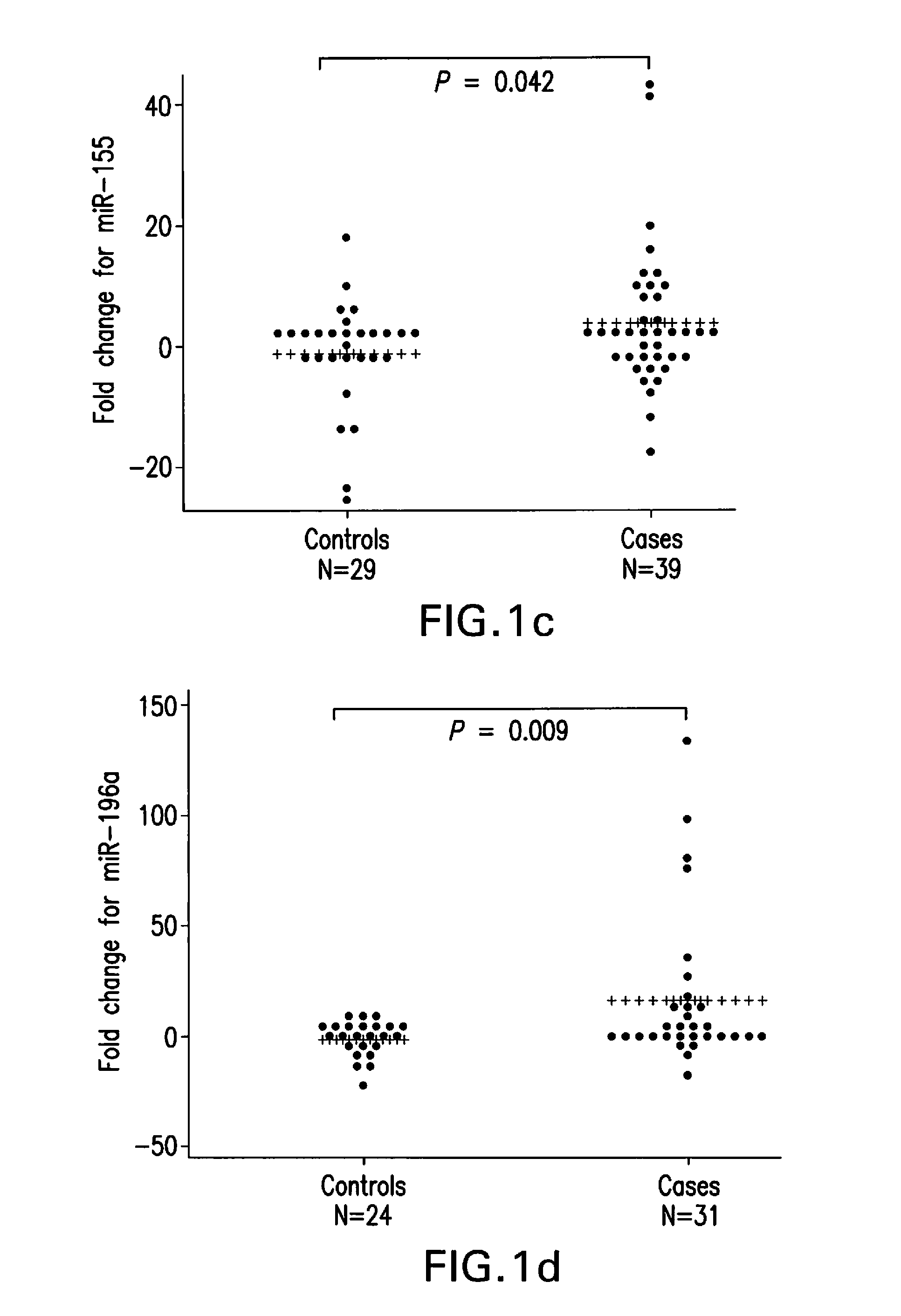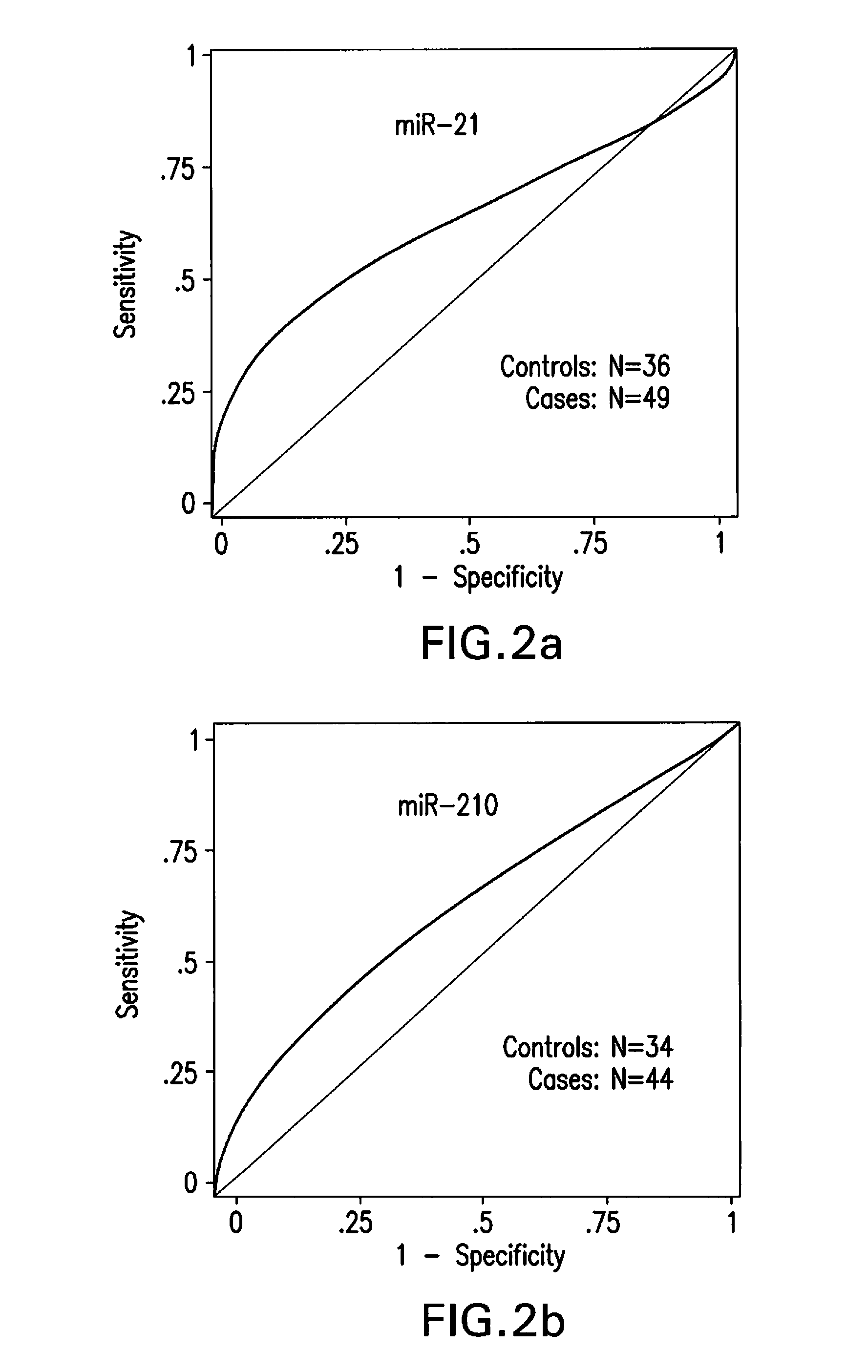miRNA DETECTION OF PANCREATIC CANCER
- Summary
- Abstract
- Description
- Claims
- Application Information
AI Technical Summary
Benefits of technology
Problems solved by technology
Method used
Image
Examples
example 1
Materials and Methods
[0097]The three different study population screened in our studies consisted of patients with pathologically confirmed primary pancreatic ductal adenocarcinoma, chronic pancreatitis and controls recruited at The University of Texas M. D. Anderson Cancer Center, TexGen consortium and at the Mayo Clinic, Jacksonville. Controls were healthy spouses, friends, or non-blood relatives of patients with various non-gastrointestinal and non-smoking related cancers. Controls were frequency-matched to cases by age at enrollment (±5 years), sex, and race. All study subjects gave written informed consent for the interviews and the collection of blood sample in accordance with the protocols approved by the Institutional Review Board of M. D. Anderson Cancer Center and the Mayo Clinic. Total of 49 cancer and 36 control samples of Heparin treated plasma collected between 2002 and 2008; 29 cancer, 9 chronic pancreatitis and 22 control samples of EDTA treated plasma collected betw...
example 2
MicroRNAs in Plasma of Pancreatic Ductal Adenocarcinoma Patients are Blood Based Biomarkers of Disease
[0112]A modified RNA isolation protocol for real time RT-PCR assay of plasma derived miRNAs from blood collected in heparin tubes was performed as described above. This protocol yielded 100 ng-500 ng of total RNA from 1.5 ml plasma samples. The isolated RNA samples could quantify relative miRNA levels in a reproducible manner as evident from the results of at least two repeated experiments of every sample run in either duplicate or triplicate in each instance. The results of these independent experiments did not show significant differences (t-test, P=0.41). Furthermore, Pearson's correlation coefficient revealed significant positive correlation between the relative miRNA levels quantified in independent experiments (r=0.705, P=0.0002). The modifications introduced in the published methods to eliminate heparin and other contaminants including DNA were critical for successful real ti...
example 3
MicroRNAs in Pancreatic Juice of Chronic Pancreatitis and Pancreatic Ductal Adenocarcinoma Patients are Biomarkers of Disease
[0118]The RT-PCR assay of pancreatic juice derived miRNAs was performed as described in the protocol. There was significant correlation between the relative miRNA levels in independent experiments. In this study, we profiled the same panel of four miRNAs described above along with RNU6B as the endogenous normalization control in 50 pancreatic cancer patients (PC), 19 chronic pancreatitis patients (CP) and 19 normal controls.
[0119]The relative levels of miR-21, miR-210, miR-155 and miR-196a normalized to the levels RNU6B endogenous control were elevated overall in the pancreatic adenocarcinoma patients (FIG. 3) but in case of chronic pancreatitis only miR-21, miR-210 and miR-155 were elevated at significant levels compared to the normal control subjects (FIG. 4). The overall mean fold increase for each of the four miRNAs in the pancreatic juice of cancer sample...
PUM
| Property | Measurement | Unit |
|---|---|---|
| Level | aaaaa | aaaaa |
Abstract
Description
Claims
Application Information
 Login to View More
Login to View More - R&D
- Intellectual Property
- Life Sciences
- Materials
- Tech Scout
- Unparalleled Data Quality
- Higher Quality Content
- 60% Fewer Hallucinations
Browse by: Latest US Patents, China's latest patents, Technical Efficacy Thesaurus, Application Domain, Technology Topic, Popular Technical Reports.
© 2025 PatSnap. All rights reserved.Legal|Privacy policy|Modern Slavery Act Transparency Statement|Sitemap|About US| Contact US: help@patsnap.com



